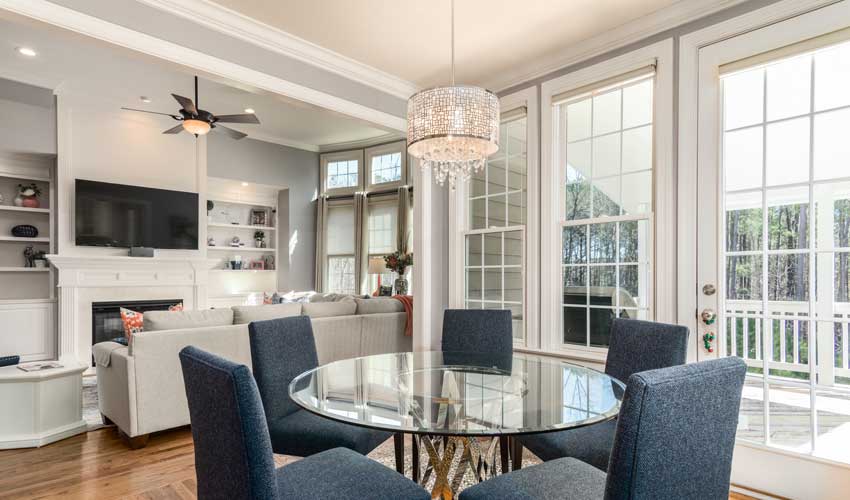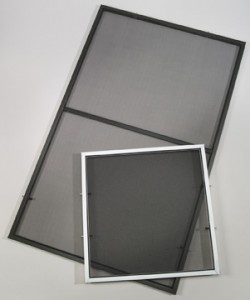Window Screens: There’s More to Consider than You Might Think

Window screens are another one of the things you will need to decide upon when purchasing windows for your new home, addition, or remodeling project.
Screens come in two basic types, fixed and retractable. Fixed screens are the ones we are all most familiar with. They have a simple frame around them and they fit into the window frame either on the interior or exterior of the window. Retractable window screens do just that. They retract, or roll up, into a pocket either at the top of the window or at the side.
Fixed screens have the advantage of being low cost, but the disadvantage of being always visible and they need to be installed and removed with the season. Retractable screens have the advantage of being out of the way until you need them. This is an aesthetic benefit, but it has the added bonus that they stay clean much longer. Their disadvantage is they cost quite a bit more than fixed screens. Retractable screens are available from only a couple of manufacturers or from a third party retrofit supplier, like Phantom Screens.
If you use fixed screens, you will have to pick the color of the screen frame. Double and single hung windows have screens mounted on the exterior. So the color should be compatible with your exterior trim color. Casements and awnings have screens mounted on the interior, so the interior trim color in your rooms needs to be considered.
Most screens have a frame made of aluminum. These come in only a couple of color options. But like the handles and latches, white is most often the best choice. A few of the high-end windows companies now offer a true wood finish. It is actually a thin wood veneer that has been laminated onto an aluminum frame. The wood allows you to paint or stain the frame exactly the same way you finish the interior of the window and the window trim.
Give some thought to how the screens go in and out of the house window and how they are held in place. Some mount in grooves with a spring catch; some lock into place with little metal tabs. One manufacturer I know of uses little spring pins. The trouble with this design is that when you are putting the screens in place, you need four hands to hold the four pins in the retracted position or else the paint on the window will get marked up. This is very awkward since not many of us have four hands.
These days, most house window screens are made of fiberglass fibers. This makes them immune to the rusting and deforming that were the bane of metal screens used in an earlier era. Fiberglass screening can be easily cleaned. A clever way to clean a screen quickly is to lay it flat on a scrap piece of carpet and wash it with a soft brush. That way you won’t push the screening out of shape. Once in a while I hear of someone wanting metal screens. For the life of me I do not know why. There are so many disadvantage to metal screens. I’ve even heard of people requesting copper screens. Unless you have some very aggressive bugs with razor-sharp teeth, this is an unnecessary expense.
Recently, several manufacturers have introduced screens made with a very fine fiber. This makes the screening nearly invisible, allowing more daylight in and improving the view when you look out. Ask about this very nice option. It might be worth the extra cost. You could select these high visibility screens for only the windows that have your view and stick with the standard screens for bedrooms or other rooms to keep the costs down. There is no rule that says you need the same type of screens throughout the house.
Another innovative window screen is one that blocks pollen from entering but allows air to come in. No window manufacturers offer it. It is available from a third party and can be installed in a standard window screen frame. I installed one of these on my bedroom window. We live in North Carolina where the spring pollen falls like snow and if you open the windows during pollen season, everything gets covered with a lime green dusting. These screens do what they say, allowing air and blocking pollen. But because the very fine polyester fibers are so numerous and so close together, they distort your vision. Everything is out of focus when you look through the screen. As a result, these pollen-proof screens are not appropriate for view windows or screened porches. But they are very nice for bedroom windows where there probably is a blind over the window anyway.
I hope this information is helpful to you. You might want to get yourself a copy of my best-seller, Designing Your Perfect House. It is chockfull of valuable tips and advice that will save you many times the cost of the book on your house building or remodeling project. You might also like The Well-Centered Home: Simple Steps to Increase Mindfulness, Self-Awareness, and Happiness Where You Live. It will show you how to make your home a happy place.



